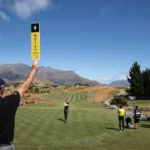
By James Beston
New Zealand’s fairways are greener than ever – but beneath the surface, a perfect storm of neglect threatens the future of the game. While Golf NZ CEO Jeff Latch celebrates “colossal growth” – a 50% surge in club membership over five years – the infrastructure supporting this renaissance is crumbling. This paradox defines our crossroads: unprecedented participation meets systemic decay.
The Fractured Foundation
Aging fleets, safety failures: When 85% of maintenance equipment is fully depreciated, clubs operate on borrowed time. Machinery meant for 5,000 annual rounds now strains under 7,000–9,000, accelerating breakdowns and safety risks. Recent audits reveal over 400 OH&S violations nationwide – from unguarded mower blades to toxic chemical storage. The era of “Kiwi ingenuity” masking negligence must end before tragedy strikes.
Staff exodus, institutional amnesia
Clubs have hemorrhaged over 1,000 cumulative years of agronomic expertise in a decade. Superintendents flee untenable conditions: boards ignore bullying by entitled members, while workloads balloon without support. Adding 200–300 members without increasing pro shop, F&B, or turf staff is managerial malpractice.
The Governance Gap
Volunteer boards, while well-intentioned, often lack critical expertise. As one architect notes, “The revival of golf clubs isn’t a strong trend due to capital constraints”. The Takapuna Golf Course saga exemplifies this: when Auckland Council proposed halving the course for flood protection, Golf NZ scrambled for alternatives but revealed a reactive, not strategic, mindset. Would we let a fisherman run a dealership? Yet clubs trust multimillion-dollar assets to directors unequipped for complex financial, environmental, or HR challenges.
The Cultural Chokehold
Elitism persists despite growth. We welcome women yet police their attire (“tights and colourful tops”). We claim to nurture juniors but resent tournaments “taking over” courses—even as events like the NZ Open’s Hyundai Futures Festival engage 320+ children, proving youth interest is soaring. Meanwhile, fee structures remain stuck in 2005, starving clubs of reinvestment capital.
Pathways to Renaissance
1. Professionalise Governance: Boards need term limits, mandatory training, and blended expertise (finance, agronomy, law). The NZ Golf Industry Council’s 2025 conference on “Leading Change” offers templates.
2. Modernise Revenue Streams:Increase subs and F&B prices gradually, tied to visible improvements.
3. Embrace Multifunctionality: Takapuna’s public course—a “lifeline during COVID”—hosts walkers and birdwatchers alongside golfers. Hybrid models like this reconcile community needs with revenue .
4. Invest in Talent: Create career pathways via CMANZ or NZTI scholarships and protect staff from member harassment. Retention starts with respect.
The Choice Before Us
New Zealand golf isn’t dying—it’s being suffocated by its own success. As global rankings celebrate our world-class courses (Paraparaumu, Tara Iti etc), everyday clubs languish . We can cling to nostalgia, watching conditions deteriorate and talent flee. Or we can evolve: welcoming diverse players, funding modern fleets, and empowering professionals to steward our clubs.
The NZ Open’s 523 volunteers from 143 clubs show our communal spirit. Now channel that energy into systemic change. In 2050, let’s celebrate not just more hole-in-ones, but a thriving, inclusive game built to last.
ABOUT THE AUTHOR:
James Beston, born in Sydney, Australia, began playing golf at age 5 and quickly developed into a talented player, reaching a single-figure handicap by 14. He pursued collegiate golf at the University of Hawaii, where he earned accolades including Golfer of the Year and Team Captain in 2003 and 2004, before competing professionally on the NZPGA Tour, PGA Tour of Australasia, and Japan Golf Tour.
After his touring career, James transitioned into leadership roles across New Zealand and Australia, notably working with Sir Michael Hill and ASX-listed Flexigroup. He has since held senior executive positions, including Managing Director of The Family Kitchen, General Manager at Whangamata Golf Club and interim GM at Windross Farm Golf Club where he has applied his strengths in strategic planning, operations, and financial management.
Now serving as Managing Director of a New Zealand-based golf consultancy backed by over 250 years of combined industry experience, James blends his elite golf background with proven business acumen to drive success in the golf industry.







I would argue that golf clubs are being choked by NZ Golf more than anything this article promotes. I represent a country club in Canterbury. Our annual membership is less than $600 yet from this we pay $43.49 per member to NZ Golf. For what in return? We still have to pay for Dot Golf, yet see that NZ Golf is supporting Daniel Hillier a touring professional golfer.
Why not ask Jeff Latch what is being done for 7.4% of a members subscription to help our members. For payment of our District Levies we get a return, tournaments and interclub. From New Zealand we get what? We see other District Associations have paid NZ Golf staff helping them, our nearest DA, Aorangi a prime example.
For a club of our size, just under 300 members over $10,000 in NZ Golf levies per annum is galling and we could spend this money on our course or machinery. Wouldn’t an article asking what value we get for our membership. I am sure there are many smaller clubs in New Zealand who have the same problem as ours that would prefer this question be asked of our parent rather than challenge the very thing that holds us small clubs together.
Hello,
The thing most people think is that DotGolf and Golf NZ are the same entity. Yes you have to pay for DotGolf, a course booking system. Look up Northstar and see what an expensive tee/subs/house account/functions etc. the scope is huge. DG is a partner of Golf NZ just like Golf Australia, golf Ireland etc. it’s a software company.
Here is the comedy.
All members of a golf club are emotionally invested. Volunteers 100 times more. Golf clubs believe that they should get unlimited service for free, Xero help for free even though DG doesn’t own Xero they only intergrate.they don’t own Lightspeed, they only intergrate.
Golf clubs do at times need assistance and this is why some senior leaders in the golf management community are coming together to launch our new consultancy.
To assist clubs where they cannot find any help elsewhere.
We offer some pro one solutions and some solutions put together based on club revenue, not just a flat rate!!
So 43.91 PP NZ golf subs to cover an entire sport. National championships that are played by young people, all abilities by all ages, women for Nz golf mostly young . We as the players of the game have to fund that or there will be no more Ryan fox, Dan Hilliard, james Hyde’s coming through at all!!
I think one of your points is covered in the article, in that we continue to only charge $600 P/A for a membership and then complain that we aren’t getting enough from our National Body. The suffocation is coming from trying to run a multi-million-dollar asset on only $180g P/A income, amongst a club of 150 ungrateful sporting “use-to-be’s”.
The $10g you may save in affiliation fees wouldn’t buy you a fifth of one machine. Golf NZ have helped many clubs when they have asked for help with things like Governance, Golf Development, Constitutions, Club Structure and more, so they are there when any club needs them. I’d be interested to know what your club has asked of them.
Another small(er) club is missing the point by making a couple of incorrect assumption.
We do not 150 ungrateful sporting “use-to-be’s”. We have a base of many volunteers who all contribute in their various to provide a very successful club. We certainly do not have a million dollar asset and membership subs of $100k, (not every member is a full member) is supplemented with other income from green fees and social events. Our annual course budget is a very comfortable $85k per year which includes development work. The $10k payment in levies would allow more development improvements. Most of our machinery is leased or donated. We are not struggling and do not feel suffocated in any way for our revenue. My point is the $10k we pay in levies is not fair value for the return. We do not begrudge our levy payments to Canterbury Golf.
We have asked on numerous occasions for assistance from New Zealand golf and Phil Aickin has been excellent. However Grant Lewis is not excellent and beyond acknowledging our request has not actioned anything.
A 50% increase in players along with some decent increases in subs over the last couple of years must surely be contributing to some more money for investment in kit. Most businesses would be very excited by those.